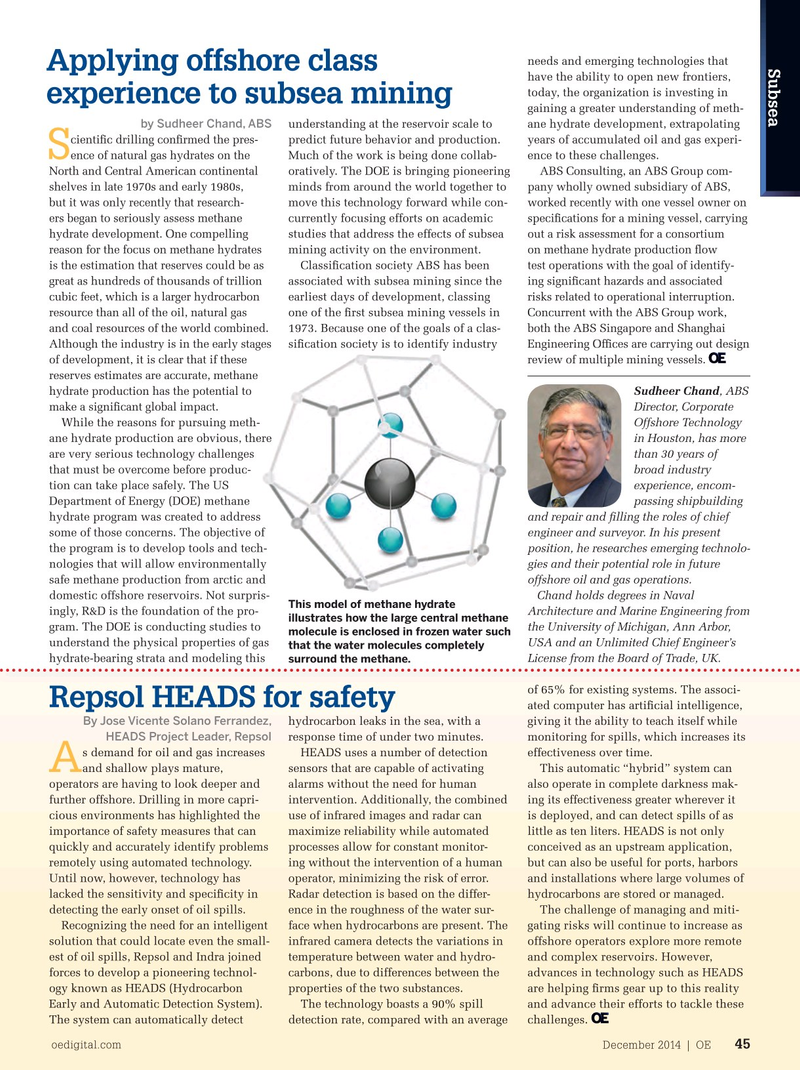
Page 43: of Offshore Engineer Magazine (Dec/Jan 2014)
Read this page in Pdf, Flash or Html5 edition of Dec/Jan 2014 Offshore Engineer Magazine
needs and emerging technologies that
Subsea Eyebrow
Applying offshore class have the ability to open new frontiers, today, the organization is investing in experience to subsea mining gaining a greater understanding of meth- by Sudheer Chand, ABS understanding at the reservoir scale to ane hydrate development, extrapolating cienti? c drilling con? rmed the pres- predict future behavior and production. years of accumulated oil and gas experi-
S ence of natural gas hydrates on the
Much of the work is being done collab- ence to these challenges.
North and Central American continental ABS Consulting, an ABS Group com- oratively. The DOE is bringing pioneering shelves in late 1970s and early 1980s, pany wholly owned subsidiary of ABS, minds from around the world together to but it was only recently that research- worked recently with one vessel owner on move this technology forward while con- ers began to seriously assess methane speci? cations for a mining vessel, carrying currently focusing efforts on academic hydrate development. One compelling out a risk assessment for a consortium studies that address the effects of subsea reason for the focus on methane hydrates on methane hydrate production ? ow mining activity on the environment. is the estimation that reserves could be as test operations with the goal of identify-
Classi? cation society ABS has been great as hundreds of thousands of trillion ing signi? cant hazards and associated associated with subsea mining since the cubic feet, which is a larger hydrocarbon risks related to operational interruption. earliest days of development, classing resource than all of the oil, natural gas Concurrent with the ABS Group work, one of the ? rst subsea mining vessels in and coal resources of the world combined. both the ABS Singapore and Shanghai 1973. Because one of the goals of a clas-
Although the industry is in the early stages Engineering Of? ces are carrying out design si? cation society is to identify industry of development, it is clear that if these review of multiple mining vessels. reserves estimates are accurate, methane
Sudheer Chand, ABS hydrate production has the potential to
Director, Corporate make a signi? cant global impact.
While the reasons for pursuing meth- Offshore Technology ane hydrate production are obvious, there in Houston, has more are very serious technology challenges than 30 years of that must be overcome before produc- broad industry tion can take place safely. The US experience, encom-
Department of Energy (DOE) methane passing shipbuilding hydrate program was created to address and repair and ? lling the roles of chief some of those concerns. The objective of engineer and surveyor. In his present the program is to develop tools and tech- position, he researches emerging technolo- nologies that will allow environmentally gies and their potential role in future safe methane production from arctic and offshore oil and gas operations.
domestic offshore reservoirs. Not surpris- Chand holds degrees in Naval
This model of methane hydrate ingly, R&D is the foundation of the pro- Architecture and Marine Engineering from illustrates how the large central methane gram. The DOE is conducting studies to the University of Michigan, Ann Arbor, molecule is enclosed in frozen water such understand the physical properties of gas USA and an Unlimited Chief Engineer’s that the water molecules completely hydrate-bearing strata and modeling this License from the Board of Trade, UK.hydrate-bearing strata and modeling this License from the Board of Trade, UK.
surround the methane.
of 65% for existing systems. The associ-
Repsol HEADS for safety ated computer has arti? cial intelligence,
By Jose Vicente Solano Ferrandez, hydrocarbon leaks in the sea, with a giving it the ability to teach itself while
HEADS Project Leader, Repsol response time of under two minutes. monitoring for spills, which increases its s demand for oil and gas increases HEADS uses a number of detection effectiveness over time.
A and shallow plays mature, sensors that are capable of activating This automatic “hybrid” system can operators are having to look deeper and alarms without the need for human also operate in complete darkness mak- further offshore. Drilling in more capri- intervention. Additionally, the combined ing its effectiveness greater wherever it cious environments has highlighted the use of infrared images and radar can is deployed, and can detect spills of as importance of safety measures that can maximize reliability while automated little as ten liters. HEADS is not only quickly and accurately identify problems processes allow for constant monitor- conceived as an upstream application, remotely using automated technology. ing without the intervention of a human but can also be useful for ports, harbors
Until now, however, technology has operator, minimizing the risk of error. and installations where large volumes of lacked the sensitivity and speci? city in Radar detection is based on the differ- hydrocarbons are stored or managed. detecting the early onset of oil spills. ence in the roughness of the water sur- The challenge of managing and miti-
Recognizing the need for an intelligent face when hydrocarbons are present. The gating risks will continue to increase as solution that could locate even the small- infrared camera detects the variations in offshore operators explore more remote est of oil spills, Repsol and Indra joined temperature between water and hydro- and complex reservoirs. However, forces to develop a pioneering technol- carbons, due to differences between the advances in technology such as HEADS ogy known as HEADS (Hydrocarbon properties of the two substances. are helping ? rms gear up to this reality
Early and Automatic Detection System). The technology boasts a 90% spill and advance their efforts to tackle these
The system can automatically detect detection rate, compared with an average challenges. oedigital.com December 2014 | OE 45 000_OE1214_Subsea3.indd 45 11/21/14 4:59 PM

 42
42

 44
44